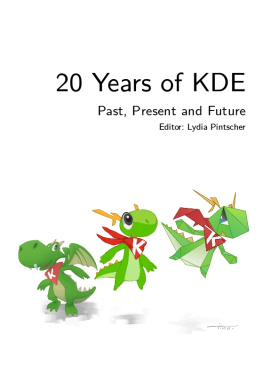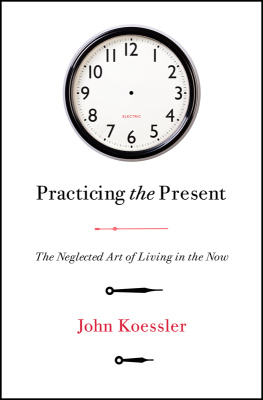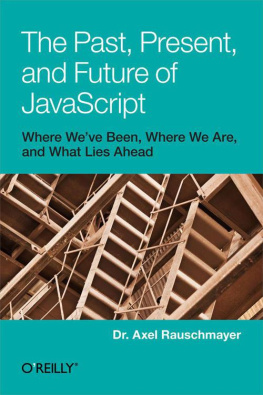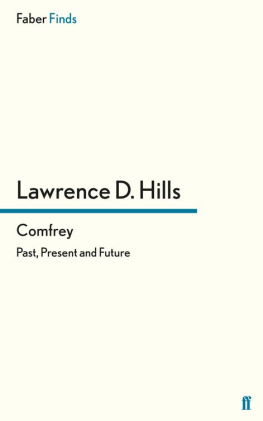Lydia Pintscher (editor) - 20 Years of KDE: Past, Present and Future
Here you can read online Lydia Pintscher (editor) - 20 Years of KDE: Past, Present and Future full text of the book (entire story) in english for free. Download pdf and epub, get meaning, cover and reviews about this ebook. year: 2016, publisher: Lulu.com, genre: Computer. Description of the work, (preface) as well as reviews are available. Best literature library LitArk.com created for fans of good reading and offers a wide selection of genres:
Romance novel
Science fiction
Adventure
Detective
Science
History
Home and family
Prose
Art
Politics
Computer
Non-fiction
Religion
Business
Children
Humor
Choose a favorite category and find really read worthwhile books. Enjoy immersion in the world of imagination, feel the emotions of the characters or learn something new for yourself, make an fascinating discovery.
- Book:20 Years of KDE: Past, Present and Future
- Author:
- Publisher:Lulu.com
- Genre:
- Year:2016
- Rating:4 / 5
- Favourites:Add to favourites
- Your mark:
- 80
- 1
- 2
- 3
- 4
- 5
20 Years of KDE: Past, Present and Future: summary, description and annotation
We offer to read an annotation, description, summary or preface (depends on what the author of the book "20 Years of KDE: Past, Present and Future" wrote himself). If you haven't found the necessary information about the book — write in the comments, we will try to find it.
20 Years of KDE: Past, Present and Future — read online for free the complete book (whole text) full work
Below is the text of the book, divided by pages. System saving the place of the last page read, allows you to conveniently read the book "20 Years of KDE: Past, Present and Future" online for free, without having to search again every time where you left off. Put a bookmark, and you can go to the page where you finished reading at any time.
Font size:
Interval:
Bookmark:
20 Years of KDE
Lydia Pintscher (Editor)
20 Years of KDE
Past, Present and Future
Copyright 2016 Sandro Andrade, Sanjiban Bairagya, PradeeptoBhattacharya, Mirko Boehm, Scarlett Clark, Ben Cooksley, AndreasCord-Landwehr, Matthias Ettrich, David Faure, Mario Fux, TimotheGiet, Frederik Gladhorn, Martin Grlin, Boudhayan Gupta, DaniGutirrez Porset, Vishesh Handa, Riccardo Iaconelli, Volker Krause,Sebastian Kgler, Sinny Kumari, Antonio Larrosa, Richard J.Moore, David Narvez, Baltasar Ortega, Kvin Ottens, ThomasPfeiffer, Nuno Pinheiro, Lydia Pintscher, Aleix Pol i Gonzlez, JensReuterberg, Cornelius Schumacher, Bhushan Shah, Yash Shah,Aracele Torres, Albert Vaca, Sune Vuorela, Franklin Weng, ValorieZimmerman

This work is licensed under a Creative Commons Attribution-ShareAlike3.0 License. To view a copy of this license visit:
http://creativecommons.org/licenses/by-sa/3.0/legalcode .
ISBN: 978-1-365-35997-2
for gearheads
all around the world
Our vision:
A world in which everyone has control over their digital life and enjoys freedom and privacy.
This book would not have been possible without the support of each ofthe authors and the following people, who helped make it happen:
- Alejandro Daniel Wainzinger Mateu
- Aleix Pol i Gonzlez
- Celeste Lyn Paul
- Frederik Gladhorn
- Valorie Zimmerman
- Volker Krause
- Will Stephenson
Aracele Torres
Aracele Torres fell in love with KDE technologies in 2007 and in 2010 decided that she should start to contribute to the community. Since then she has made contributions in many areas, such as translation, promotion, artwork, and community management. She travels through Brazil, giving talks about KDE and organizing activities to promote the community. Additionally she participates in the organization of KDEs Latin-America Summit LaKademy since its first edition. She is a doctoral student in the History of Science and Technology, conducting research on the history of digital technology, free software, the internet and related things.
KDE as a software project was born in 1996 when German programmerMatthias Ettrich realized that Unix-based systems were growing, buttheir interfaces were not user-friendly enough for the end user. It wasonly three years after the first GNU/Linux distributions had begun toappear and Matthias noticed the absence of a graphical user interfacethat offered a complete environment for the end user to perform theirdaily tasks. He thought that for the people who began to considerGNU/Linux as an alternative to proprietary systems, a beautiful andeasy to use graphical environment would help a lot. Thus was born theproject Kool Desktop Environment or simply KDE. The name was apun on the proprietary graphical environment very popular at the time,CDE (Common Desktop Environment) that also ran on Unixsystems.
One year after Matthias Ettrichs announcement inviting developers tojoin the project, the first beta of KDE was released. Nine months latercame the first stable release. The dream of Matthias and his communityof contributors was becoming reality and occupying an important placein the history of free software. The project was maturing and becomingmore complex and more complete. Thanks to the collaboration ofpeople worldwide, KDE had grown from version 1 to 2 in 2000,and then to 3 in 2002. In 2008, after very important changes, thecommunity launched the revolutionary version 4. In 2014, the equally innovative version 5 came out that showed in its visual design,framework, and applications that the community is ready for thefuture.
During this time, a lot had changed in the KDE Community and itstechnologies. First came the change of KDEs name and its identity. In2008, the community began to refer to KDE as not just a softwareproject, but as a global community. This identity change was madeofficial in 2009 when the community announced this rebranding. Thename K Desktop Environment was dropped because it no longerrepresented what KDE had become. This long name had becomeobsolete and ambiguous, since it represented a desktop that thecommunity has developed. KDE at that point had become morethan just a desktop, evolving into something greater: KDE was no longer the software created by people, but the people who create software.
Outside observers of the KDE Community may not have noticed, butthis rebranding was a turning point in the history of KDE. Through it,the community makes clear its ability to perceive and keep upwith the state of the art of computing. The reign of desktops wasover and it made no sense to limit KDE to traditional platforms.Therefore, the decision to use only the name KDE intended tocommunicate to users that the community was attentive to thefuture. KDE would not only be synonymous with a limited set ofsoftware components, but be synonymous with the internationalcommunity that produces free technologies for the end user, whether fordesktop or mobile devices or other technologies that are yet tocome.
In 2012, this rebranding effort was summarized in a manifesto. TheKDE Manifesto listed core values advocated by the community and itserved as an open call: New projects are now welcome under the KDEumbrella brand. This led to the creation of the KDE Incubator in 2014.The KDE Incubator serves as an integration point for new free softwareprojects that join the community to have the same benefits as theexisting KDE projects. This incubator has become home to a variety ofprojects, from a wiki dedicated to educational topics to a full-fledged Linux distribution.
KDE continues the same trend it has followed the past 20 years,which is inclusive growth. Its founding principle was based onproviding users a better desktop experience. It has expanded that viewto also offer the best experience on mobile devices. The futureis ripe with possibilities for a new generation of devices: cars,smart TVs, refrigerators, stoves, etc. Can you imagine a smarthome or even an entire city using the technologies of the KDECommunity?
For almost 10 years I have used the technologies that the KDECommunity produces. I remember starting with KDE 3.5 when I still didnot even know about the social importance of free software. As a user, asa contributor, and as a historian, when I look back at these 20 years ofhistory, the feeling is the same. The KDE project was born from theinterest of a group of people who wanted to make computing, especiallyfree and open computing, accessible to all. The 1990s was a time whenthe GNU/Linux systems became popular and the internet and the webwas becoming more present in peoples lives. KDE emerged as animportant tool in the popularization of free software. Born with theintent to be an interface between a person and the computer, todayKDE is an interface between people. KDE unites and connectspeople through free computing. KDE has become a communitythat encourages the growth of people and projects, that seeksinnovation, and defends the free sharing of information. KDE has movebeyond simply being computer software and has evolved to become aculture.
Next pageFont size:
Interval:
Bookmark:
Similar books «20 Years of KDE: Past, Present and Future»
Look at similar books to 20 Years of KDE: Past, Present and Future. We have selected literature similar in name and meaning in the hope of providing readers with more options to find new, interesting, not yet read works.
Discussion, reviews of the book 20 Years of KDE: Past, Present and Future and just readers' own opinions. Leave your comments, write what you think about the work, its meaning or the main characters. Specify what exactly you liked and what you didn't like, and why you think so.













